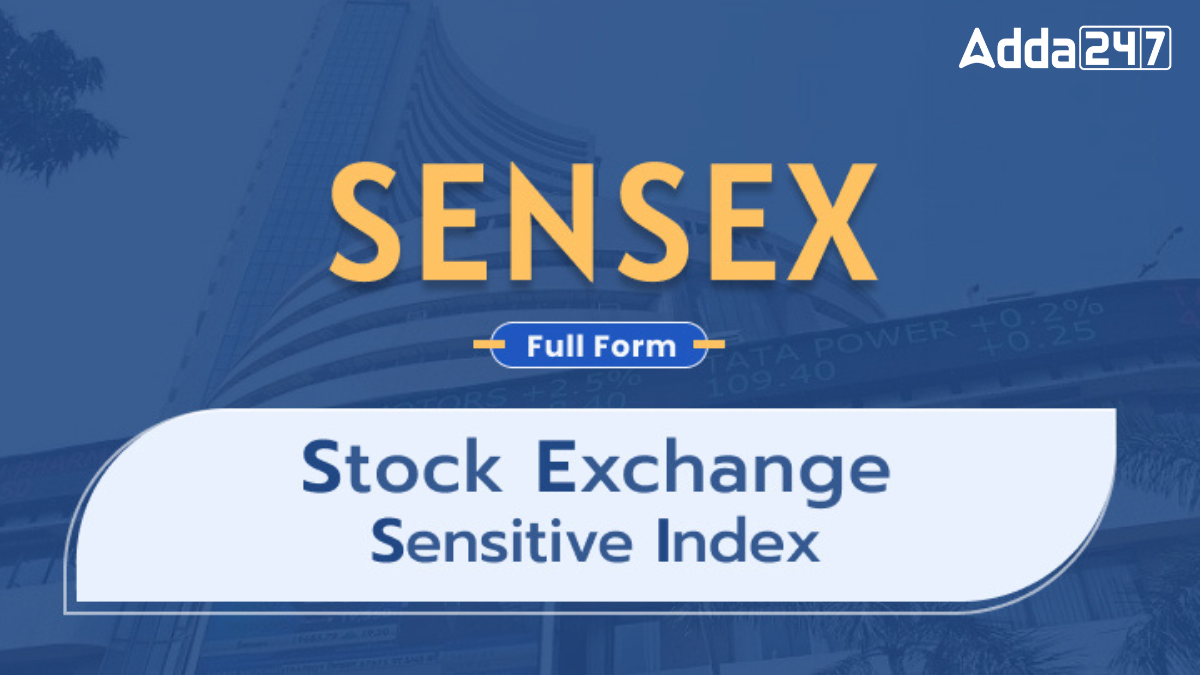Its Overview, Characteristics, Components, Advantages and Functions [Current Affairs]
The SENSEX, short for Stock Exchange Sensitive Index, is a crucial stock market index in India. It reflects the performance of the Bombay Stock Exchange (BSE), representing 30 of the most financially sound and well-established companies. These companies are often referred to as blue-chip firms and span various industries across the Indian economy.
Full Form of SENSEX
The full form of SENSEX is Stock Exchange Sensitive Index. It reflects the performance of 30 major and frequently traded stocks listed on the Bombay Stock Exchange (BSE) in India. Created in 1986, the SENSEX is a crucial benchmark for evaluating the health of the Indian stock market and is used by investors to gauge economic trends and market sentiment.
An Overview to the SENSEX
The Sensex, established on January 1, 1986, is designed to reflect the performance of India’s 30 largest and most influential companies listed on the BSE. It provides insights into the country’s economic trends and the performance of key sectors. The index is both float-adjusted and market-capitalization-weighted, making it a comprehensive measure of the market’s health.
Key Characteristics of the SENSEX
- Historical Background: Created in 1986, the Sensex is the oldest stock index in India and is administered by S&P.
- Calculation: It is computed in Indian Rupees (INR) and U.S. Dollars (USD).
- Adjustment Method: Float-adjusted and market-capitalization-weighted, considering only the shares that are freely traded.
- Semi-Annual Assessment: The index is reviewed and updated semi-annually, between June and December.
Components of the SENSEX
The Sensex comprises 30 of the most significant and frequently traded stocks on the BSE. As of August 31, 2021, the top five companies included:
- Reliance Industries
- HDFC Bank
- Infosys
- Housing Development Finance Corp.
- ICICI Bank
These companies are selected based on their market capitalization, liquidity, and financial health.
Historical Significance of the SENSEX
- 1992 Crash: On April 18, 1992, the Sensex experienced its worst fall of 12.7% due to a financial scandal involving a senior broker.
- 2000s Boom: The index saw tremendous growth during the 21st century, reflecting India’s rapid economic expansion.
- Pandemic Impact: The Sensex dropped about 40% in March 2020 amid the global coronavirus pandemic but rebounded to reach an all-time high around February 2021.
List of SENSEX Constituent Companies
The SENSEX comprises 30 top companies from different sectors, showcasing a diverse representation of the Indian economy. The current constituents include:
- Lupin
- Tata Steel Limited
- Wipro Limited
- Tata Motors Limited
- State Bank of India
- Sun Pharmaceutical Industry Limited
- Tata Motors – DVR Ordinary
- Tata Consultancy Services Limited
- Kotak Mahindra Bank Limited
- Mahindra and Mahindra Limited
- Maruti Suzuki India Limited
- Larsen and Toubro Limited
- Reliance Industries Limited
- NTPC Limited
- Power Grid Corporation of India Limited
- Oil and Natural Gas Corporation Limited
- Viola
- ITC Limited
- Infosys Limited
- ICICI Bank Limited
- HDFC Bank Limited
- Hindustan Unilever Limited
- Hero MotorCorp Limited
- Housing Development Finance Corporation Limited
- Asian Paints Limited
- Bajaj Auto Limited
- Axis Bank Limited
- Bharti Airtel Limited
- Adani Ports and Special Economic Zone Limited
- Coal India Limited
- Reddys Laboratories Limited
Advantages of Being Listed on SENSEX
Being part of the SENSEX offers several advantages for listed companies:
- Enhanced Visibility and Reputation Companies included in the SENSEX benefit from increased visibility and a stronger reputation. The inclusion in this prestigious index boosts the company’s market presence and valuation.
- Increased Market Interest SENSEX listing often leads to higher investor interest and a more robust market for the company’s shares, enhancing liquidity and trading volume.
- Capital Raising Opportunities Companies listed on the SENSEX have better opportunities to raise capital through equity, thanks to increased investor confidence and marketability.
- Growth and Expansion Potential Inclusion in the SENSEX provides companies with growth opportunities, including mergers, acquisitions, and expansions, supported by a strong market presence.
- Enhanced Corporate Image Being part of the SENSEX strengthens a company’s corporate image by associating it with the top-performing firms in the country.
- Improved Risk Distribution The index provides a platform for better risk management and efficiency, contributing to overall corporate stability and worker incentives.
Functions of the SENSEX
- Gauging Market Sentiment: Reflects market sentiment and performance of top Indian companies.
- Making Investment Decisions: Helps investors gauge market trends for informed decisions.
- Monitoring Economic Health: Provides insights into India’s economic landscape and investor sentiment.
- Comparing Stock Performance: Serves as a benchmark for comparing individual stock performance.
- Raising Share Capital: Enables companies to raise share capital effectively.
- Providing Growth Opportunities: Offers growth opportunities such as mergers, expansions, and acquisitions.
- Improving Company Reputation: Strengthens a company’s reputation by including top-performing firms.
Source: currentaffairs by adda247
